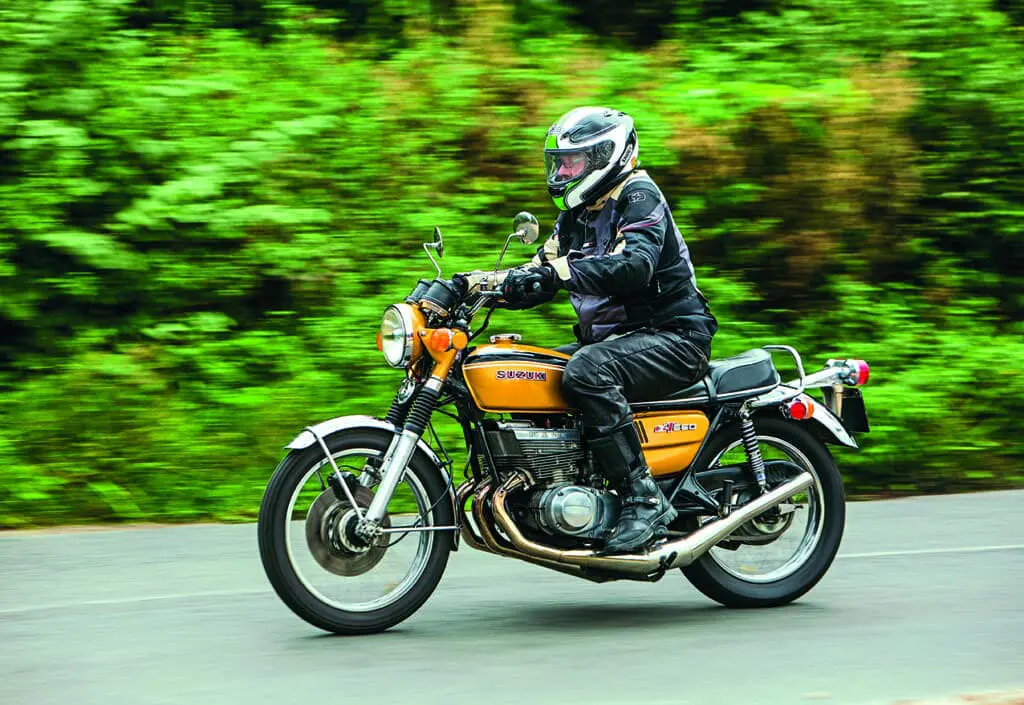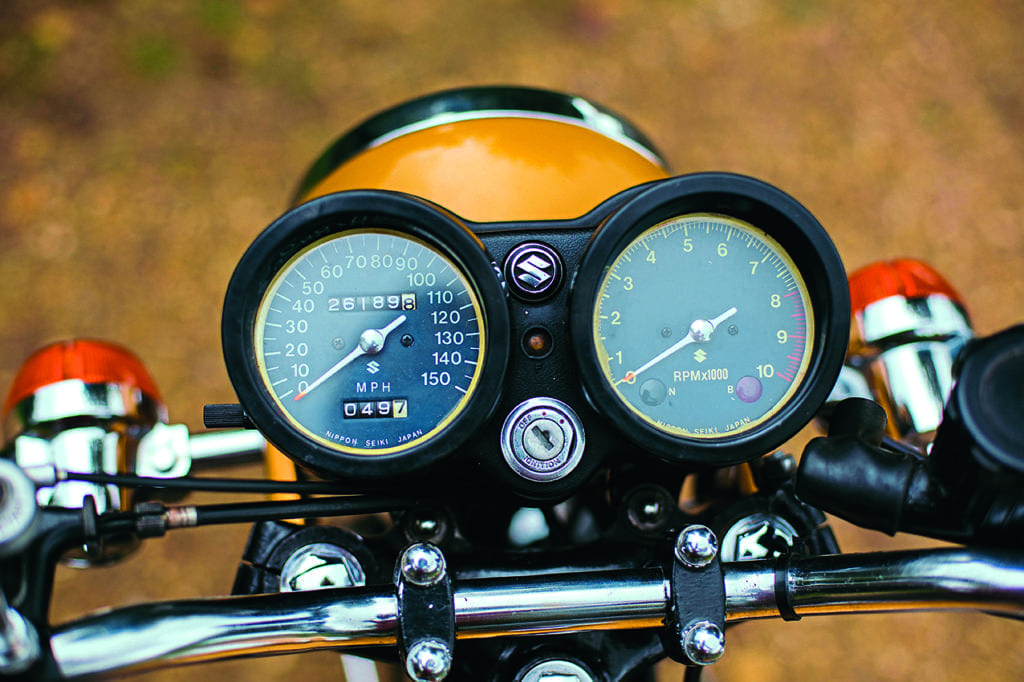“Always the bridesmaid, never the bride”; If you’re into 1970s classics then that phrase may strike a chord with you when run alongside Suzuki’s GT550.

For reasons that are as biased as they are inaccurate, the middleweight triple has perpetually lived in the shadow of the Kawasaki H1 both then and now. Back in the day, in the UK at least, some insurance companies ran a capacity break from 351-499 ccs which meant, against all logic and common sense, that a GT550 was perceived as more of risk than a Kawasaki 500 Mach III.
Four decades on and the Hamamatsu machine is still perceived as the poor relation, somehow a lesser entity, carries less charisma and, ultimately, is perceived as being worth less: all of which is a huge shame and totally unjustified. The two manufacturers were always aiming at different target markets and whatever anyone else might say then or now a direct comparison is about as valid as comparing apples with oranges; different flavours, different uses, different riders.
Suzuki’s logic at the time of the bike’s inception was a lot more sensible than it might at first seem. Having delivered a raft of hugely successful singles and twins; triples were the next logical step. However, Kawasaki had got there first in 1968 with their ‘take-your-brain-out, heart-into-your-mouth, bum-clenching’, 500 triple Mach III.
Where was the mileage in making an analogue of something already so iconic? Suzuki’s GT750 triple had been launched in 1971 as a genuine Grand Tourer, a two-stroke alternative to Honda’s CB750/4. Even if the contemporary test riders wanted more speed out the Kettle most riders were more than happy with its easy going performance and wide spread of power.
So if the top-end of the market was happy with the 750 why not spread the joy around and roll out similarly good natured smaller capacity machines aimed at riders that didn’t necessarily want all-out performance?

Quite why the 550 engine was chosen (it’s actually 543 cubic centimetres) is anybody’s guess but it was probably to differentiate the bike from the Kawasaki. Suzuki also needed to distance their new baby from their rather successful T500 twin. Give the raft of in-house parts Suzuki could have called on it’s tempting to suggest they might have been able to utilise say T350 pistons and T500 rods. This would have delivered a similarly unique 615 cc triple yet they chose to start almost from scratch. The resultant engine proved to be tractable and with a good turn of usable speed and that word, usable, was what the GT550 was all about.
Even if performance was not wildly different from the T500 Titan, the experience was substantially dissimilar. The almost liquid power was on hand virtually wherever it was needed, the three pot motor was silky-smooth and for a stroker there was a large amount of accessible torque. Period tests commented positively on the bike’s exploitability, the manner in which it could be hustled through traffic smartly and way it conducted itself on fast sweeping roads.
Then as now it was remarked upon that it was not a direct competitor to Kawasaki’s H1 yet still fulfilled a gap in the market for a flexible, easy to use middleweight. Forty five years on we now have the opportunity to see just how accurate those early 70s observations were.
Get your leg over and the bike immediately feels like it’s been designed for comfort. The saddle seems broad and supportive, the bars are medium high but not uncomfortably so, foot pegs are only a little way ahead of the swingarm spindle…yes it all feels rather well thought out in a gentlemanly way. Instruments are clearly legible and for once the perennial Suzuki bogie of clouded, hazy, plastic clock lenses is blissfully absent.

The vacuum tap means no fiddling around with the left hand and for once I have a bar mounted choke that stays where I set it. A small detail possibly but if you’ve ever battled with a spring loaded Kawasaki H1 choke you’ll know how disproportionately irksome a self-closing choke is. Turn the key and then press the button; the 550 has an electric foot and of course it works faultlessly every time. What happens next is pure 70s magic. Palls of grey blue smoke chuff wilfully from the spannies and as I give the throttle a self-satisfying tweak Gary the Lens jumps back in shock. The pipes crackle and bark in the way that only old strokers can.
The gearbox shifts without issue and first is easily good for 20 mph. With the decent spread of power bestowed by three pots, conservative port timing and expansion chambers to maximise potential there’s little need to dance on the pedal.
Below four grand the engine is as smooth as glass, predictable and almost docile but add an extra five hundred to the tacho and it’s off. The power builds inexorably as it blitzes its way to 6500-7000 when it’s time to hook up another ratio and repeat the exercise. It’s perfectly possible to head onwards to the red zone but in reality there’s no actual need; riding the torque curve and not the BHP trace is hugely rewarding. Anywhere between 6000-7000 grand equates the 550’s sweet spot but run the bike on a neutral throttle and there’s an underlying tendency for it to hunt. It’s nothing serious and I reckon a dyno-and-jetting session would soon sort it out.
For our riding shots I’ve found a suitable farm yard and a local garage where I can safely turn around. The mechanics at the latter come out after a couple of circuits and look on in appreciation so they get few throttle blippings by way of a thank you, they seem well pleased. Sadly Gary the Lens isn’t quite so impressed. He’s lying on low grass bank with a farm house wall on one side of the road and a barn on the other. Apparently my ride pasts are causing his ears extreme grief and we need to find somewhere less likely to reverberate with the banshee wail…kids of today eh!
Want to read on? It’s simple, just click here to purchase the March 2017 issue of CMM!



